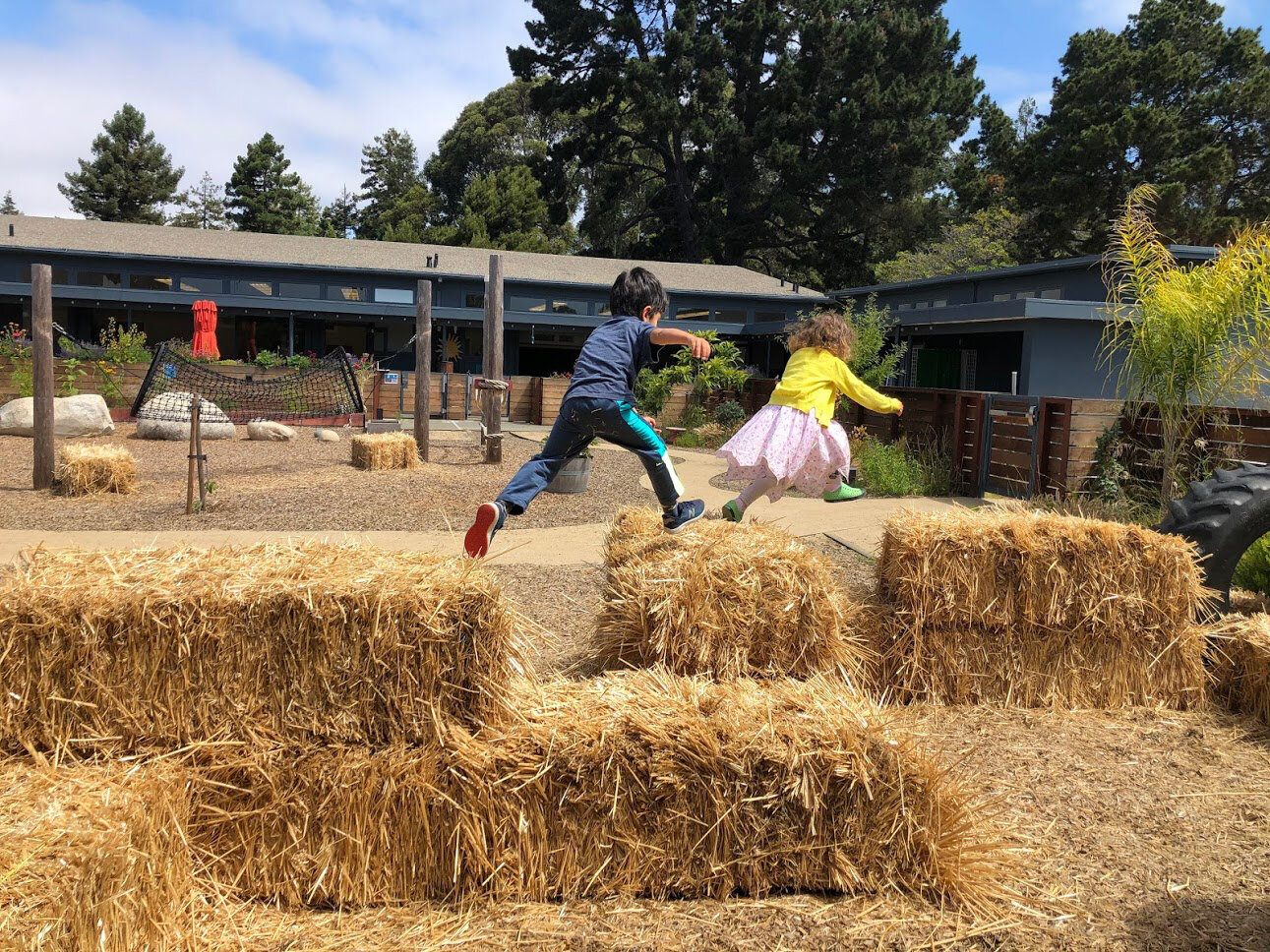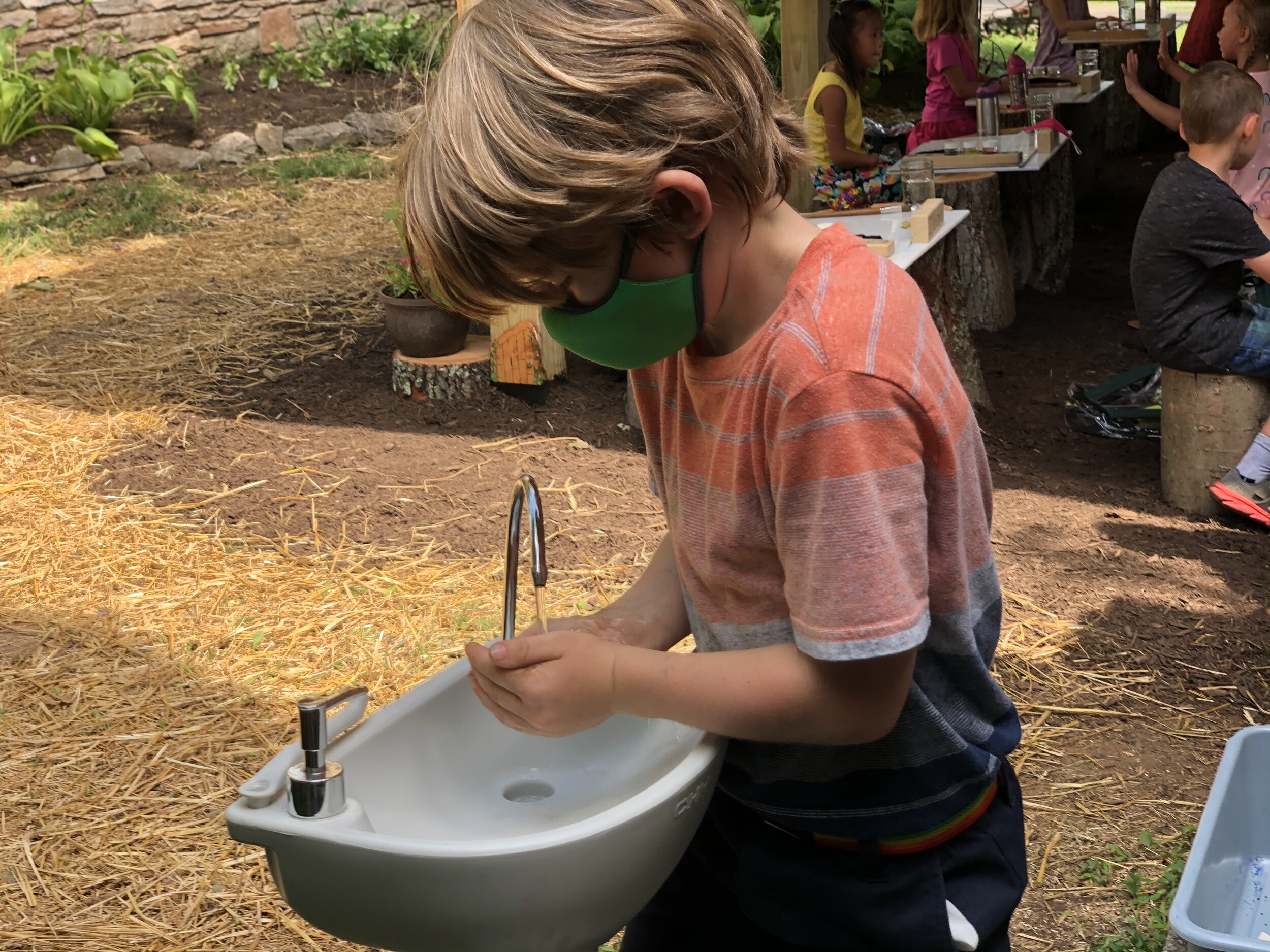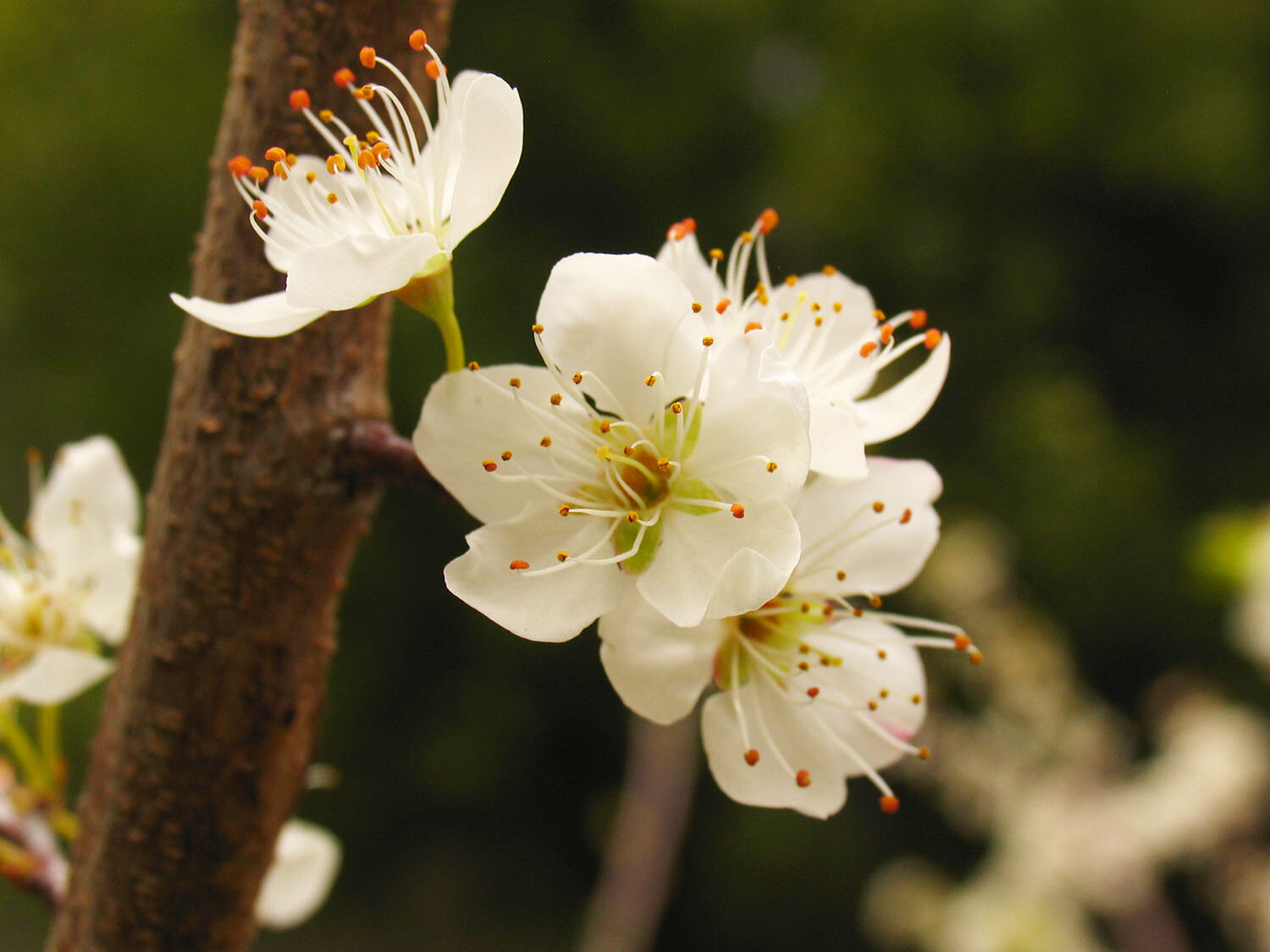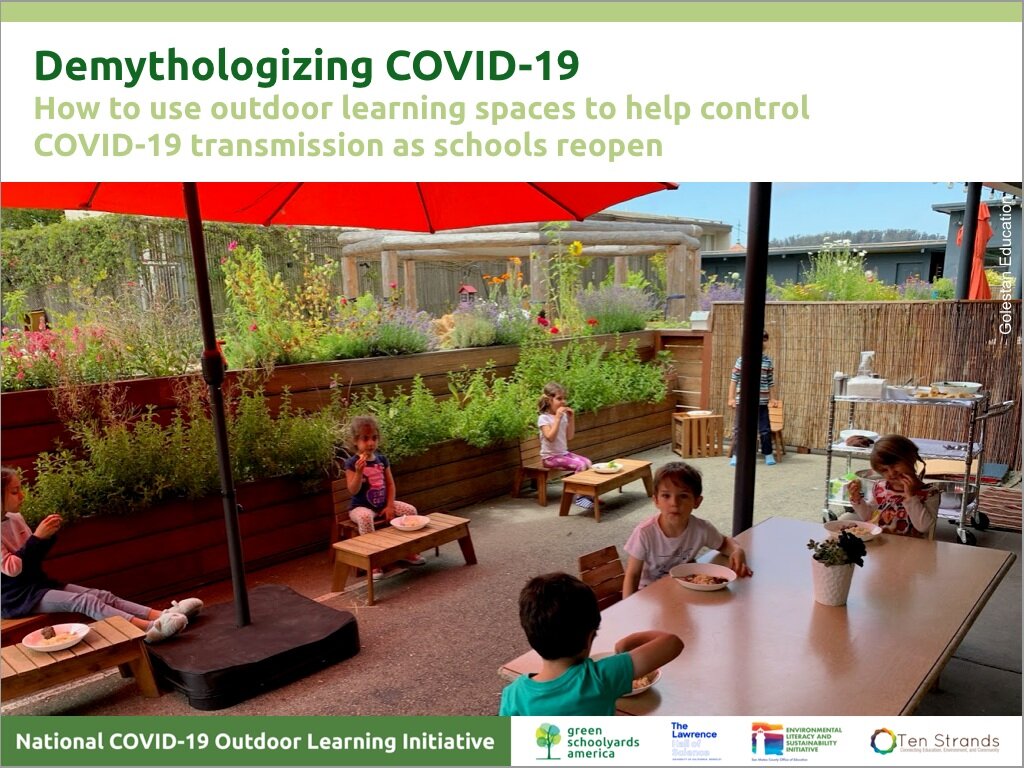CHAPTER 3
Health Benefits and Guidance
The pandemic exacerbated a growing mental health crisis for students of all ages who spent months separated from their teachers and classmates and the daily interactions that build friendships and make lessons engaging and memorable. Investing in outdoor learning now can address the urgent need for therapeutic mental health practices in response to the current crisis, and will also yield long-term health benefits for children. Research overwhelmingly supports that being in and interacting with nature improves health and well-being. These benefits extend throughout the lifespan. The articles below explore the wide range of health benefits associated with being outdoors and interacting with nature through learning and play.
Many health inequities are directly or indirectly related to lack of access to outdoor space. School grounds are often an accessible solution, and have the potential to provide all children with access to nature on a daily basis. We recognize that not all school grounds currently have trees and green space. This is an inequity that Green Schoolyards America’s long-term work seeks to address through our efforts to help school districts create “living schoolyards” with park-like environments just outside their classroom doors. Please contact us for more information about creating district-wide long-term plans to remove pavement and green school grounds at scale.
GUIDE TO SECTIONS IN CHAPTEr 3
Click on the links below to navigate directly to various sections of Chapter 3, or simply scroll down to browse.
Health Benefits of Nature and Being Outdoors
Social-emotional Benefits
Outdoor learning enhances children’s social interaction skills, confidence building, problem solving, independence, negotiation skills, and creativity.
Cognitive and Learning Benefits
Spending time in nature replenishes voluntary focus and has benefits for attention, motivation, concentration, and working memory.
Physiological Benefits
Outdoor learning enhances brain development and function, increases physical activity participation and health resiliency, and reduces risk of infectious and chronic disease.
Mental Health Benefits
Higher levels of greenness on school grounds are associated with increased sense of restoration and quality of life. Connecting with nature directly and indirectly improves childhood mental health.
Design with Mental Health in Mind
In this recorded webinar, Claire Latané, MLA shares her research and expertise about how to design outdoor school environments to promote mental health.
Being Outdoors Improves Vision and Sleep
Humans evolved to be in sunlight all day. Increasing the time spent outdoors reduces children’s incidence of myopia, improves their sleep/wake schedule, and helps them get more sleep.
What if Your Schoolyard is Entirely Paved?
Exploring the Relationship Between Inequity and Health
Many communities and individuals live with health and educational inequities stemming from structural racism, disinvestment, historical disenfranchisement, and discrimination. These inequities compound health impacts during the pandemic and have long-term consequences. Barren, paved, and deteriorated school grounds are a symptom of these widespread inequities, particularly in our cities, and deepen the health and learning inequities for children who attend school on stark campuses. The absence of nature in the places children spend their time on a daily basis denies them the mental, physical, social-emotional, and learning benefits that children in greener (often wealthier) areas are afforded. The benefits of naturalized school grounds should be available to every child.
See also, Addressing School Infrastructure Inequality
Make Long-term Plans for Transformation
Start small, but dream big. Many school grounds that are lush and green now were once paved — and your school or district can do it, too. It takes time to plan, gather the community, and put fundraising in place, but the value of having a “park” right outside the classroom door is substantial.
Invite Nature to Your Schoolyard
If your schoolyard is paved and you would like to have the benefits nature affords, visit our Creating Outdoor Spaces chapter for creative ideas, planning frameworks, and strategies.
Take Outdoor Learning Offsite
Parks, public lands, closed streets, and other outdoor spaces offer opportunities to extend learning beyond the school site. Visit our chapter on Outdoor Learning Offsite for ideas.
Making Paved Spaces Comfortable
Wondering how to make a paved schoolyard comfortable and inviting? This article offers strategies to add softness and color with art, container gardens, outdoor rugs, and more.
Managing Healthy Outdoor Spaces
Being outdoors for learning and play can make for exciting new discoveries and help students connect with the natural world. This also may mean more exposure to elements like plants, soil, animals and insects, and pollen. Bellow are creative, simple adjustments and management strategies that can help ensure outdoor spaces promote healthy ecosystems AND are comfortable and healthy for the students ands staff that spend time in them.
Handwashing Options
Health guidance recommends frequent washing or sanitizing of hands. This article frames current recommendations and suggestions for handwashing stations for outdoor spaces.
Tips for Managing Pests
Wildlife is an important part of the natural environment. Getting accustomed to the presence of animals is a key aspect of becoming more comfortable outside. This article offers tips to address common pests.
Reducing Outdoor Allergens
Many children and adults have allergies to pollen, mold, and other materials that are naturally found outside. This article describes design and management considerations to minimize allergies during outdoor learning.
Outdoor Meals at School
During the pandemic many schools tried outdoor meals for the first time. Positive responses from students, teachers, administrators, and food service staff mean that many schools will opt to continue to offer outdoor dining in the future. This chapter of the National Outdoor Learning Library shares planning guidance, best practices, and resources from the federal government and from organizations and experts across the country. These articles explore the range of issues schools and districts will need to consider when planning for students to eat meals and snacks outside.
Outdoor Meals: Getting Started (Part One)
Beginning with the reasons why to move meals outside, this article explores the considerations and planning that are the foundation of a successful outdoor meals program.
Outdoor Meals: Implementation (Part Two)
This article examines the systems and furnishings you’ll need for every aspect of mealtime outdoors: serving, eating, supervision, and cleanup.
Managing Waste at Mealtimes
Effective waste management systems for indoor or outdoor meals offer significant environmental benefits by reducing the use of raw materials and the fuel required to transport food, packaging, and waste.
Case Study: Arlington, Virginia
This case study profiles five schools in this Northern Virginia district, each with a unique approach to outdoor meals.
Case Study: Snacks and Cooking Outdoors with Children
This case study features Golestan School in El Cerrito, California and their tips and strategies for cooking outdoors with children during the pandemic.
Pandemic Health Guidance
Moving School Outside Promotes Health
Most health-related guidance during the COVID-19 pandemic has focused on indoor environments. In this section of the National COVID-19 Outdoor Learning Initiative’s online library, you will find information that specifically addresses how to reduce virus transmission using outdoor environments for learning and play, with specific attention to promoting health and educational equity.
The National Initiative recognizes that health research related to COVID-19 is ongoing, and the information on this page reflects the best science available at the time of writing.
Vaccinations to prevent COVID-19 began in the United States during December 2020. Currently, recommendations from the Centers for Disease Control and Prevention (CDC) for mask-wearing, social distancing, hand-washing or any other recommendations presented here remain the same, whether or not individuals have been vaccinated. We will continue to monitor this and update as needed per CDC guidance. We plan to update this page regularly. Please check the CDC and your local health department for most up-to-date recommendations .
This information was assembled by the National Initiative’s Health Working Group that includes public health, education, and health professionals from around the country. This group provides science-based recommendations and resources to facilitate decision-making at the local and community level, recognizing the importance of local history, culture, knowledge, priorities, and resources. We hope this information will help guide your school and district in bringing classes and programs outdoors during the pandemic, and that the long-term health benefits of being outside will inspire you to stay outside in the years to come.
Equity and Health
Before the COVID-19 pandemic, many communities and individuals lived with health and educational inequities stemming from structural racism, disinvestment, historical disenfranchisement, and discrimination. Many of these same communities and individuals have also been disproportionately harmed by the pandemic and by responses to it.
To foster healing, prevent further harm, and promote outdoor learning that builds well-being among all children, families, and educators, the National COVID-19 Outdoor Learning Initiative and this Health Working Group centers our thinking and planning on students who are already vulnerable, including students living in poverty, students of color, students with disabilities, multilingual learners, students in foster care, and youth experiencing homelessness.
Guidance for Healthy Outdoor Learning
Reliable Sources
Summary Materials from Our Initiative
When questions arise about health considerations, refer to reliable sources that are updated often. We recommend these resources published by the national Centers for Disease Control and Prevention (CDC):
For updated local guidance, such as current health orders and mandates, check with your local health department. Click here to find your local health department.
Promoting Healthy Environments
— The Basics for Outdoor Learning
How can schools create healthy learning environments to minimize the risk of virus transmission? Move outside as “Plan A.”
Demythologizing COVID-19
— Recorded Webinar
In this September webinar, Dr. Nooshin Razani, MD, MPH and Dr. Caesar Djavaherian, MD discussed questions related to using outdoor spaces as a response to the pandemic.
“Consider having activities, classes, or lunches outdoors when circumstances allow.”
— Centers for Disease Control and Prevention (CDC), Ventilation in Schools and Childcare Programs (2/26/21)
Making Healthier School Environments
There are many ways to design outdoor learning and play spaces to reduce risk of transmission, boost learning, and ensure equity. The articles below explore strategies to keep students and teachers healthy when schools reopen.
Tactics and Resources
Which sources of health information are the most reliable and useful for schools and districts? This article shares the links our Health Working Group recommends.
A Brief Guide to Local Health Rules
Whose guidance should public school districts follow? This article frames the health guidance landscape and sets local, state, and national health institutions in context.
Know Your Goals
Setting clear health goals establishes the foundation for strategies and practices that follow. This article outlines how to set goals for maintaining health using outdoor learning.
Handwashing Options
Health guidance recommends frequent washing or sanitizing of hands. This article frames current recommendations and suggestions for handwashing stations for outdoor spaces.
Planning School Transportation
Most school districts have struggled to establish protocols to reduce the risk of virus transmission for students who ride buses and use public transit. This article provides some health-related guidance and framing.
Disclaimer
This site provides general information and discussions about health and related subjects. The information and other content provided throughout this website, or in any linked materials, are not intended and should not be construed as medical advice, nor is the information a substitute for professional medical expertise or treatment.
The National COVID-19 Outdoor Learning Initiative is not formally affiliated with any academic, hospital, health practice or other institution. The opinions and views expressed on this website are based on those of an interdisciplinary set of volunteer professionals and do not reflect the official positions of any of the Initiative’s supporting organizations or the organizations with whom the professionals are affiliated.
Credits
The information in this health chapter of the National Initiative’s online library was written and assembled by our Health Working Group that includes public health, education, and health care professionals from around the country. This group provides science-based recommendations and resources to facilitate decision-making at the local and community level, recognizing the importance of local history, culture, knowledge, priorities, and resources.
The Health Working Group is led by Mary Michaud, MPP, Health & Social Impact Strategies, LLC and Zach Pine, MD, Zach Pine Create with Nature and includes a team of dedicated volunteers from around the country. Members of this working group also reviewed key documents across our National Outdoor Learning Library. We would like to express our heartfelt thanks to all of the organizations and individuals who are collaborating to make this Initiative possible.
National Outdoor Learning Library
The National Outdoor Learning Library is an expansive set of resources for schools and districts created by the National COVID-19 Outdoor Learning Initiative, which was founded in 2020 by Green Schoolyards America, The Lawrence Hall of Science, San Mateo County Office of Education, and Ten Strands. With the help of current partners, Green Schoolyards America is continuing to expand the library’s collection to support equitable access to outdoor learning and living schoolyards beyond the pandemic.































